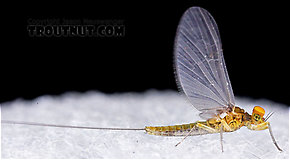Blog & Latest Updates
Fly Fishing Articles
Insects by Common Name


> > shuck and belly
The Specimen
Baetis (Blue-Winged Olives) Mayfly Dun View 14 PicturesThis dun molted most of the way into a spinner (though the wings got stuck) the evening after I photographed it, so I took some more photos of the spinner.
View 14 PicturesThis dun molted most of the way into a spinner (though the wings got stuck) the evening after I photographed it, so I took some more photos of the spinner.
I found a female nearby, probably of the same species.
 View 14 PicturesThis dun molted most of the way into a spinner (though the wings got stuck) the evening after I photographed it, so I took some more photos of the spinner.
View 14 PicturesThis dun molted most of the way into a spinner (though the wings got stuck) the evening after I photographed it, so I took some more photos of the spinner.I found a female nearby, probably of the same species.
Collected September 19, 2006 from Mystery Creek #43 in New York
Added to Troutnut.com by on October 4, 2006
Added to Troutnut.com by on October 4, 2006
The Discussion
| Martinlf | December 23rd, 2006, 5:21 pm | |
Moderator Palmyra PAPosts: 3233 | That sounds like some southern jive tune, doesn't it? I seem to recall that we had a discussion about mayfly shucks a while back, in which we discussed the more opaque and dark coloration of invaria or rotunda shucks. These acerpenna shucks look much lighter, and greyish in color. Am I right? Are they also more translucent? What color are the nymphs, and what color Z=lon would you use to imitate a shuck on an emerger for this bug? Would this hold true for most baetids? This might explain the excellent luck I've had with the Little Lehigh olive emerger, (basically an RS2 design--see the Litle Lehigh Fly Shop website) which has a shuck of natural CDC that is fairly greyish in color. Also, the first picture shows a clear difference in the color of the top and bottom of the abdomen, another good cue for dubbing color. Jason, these photos are amazing! I hope you have some luck with photos of emergers in the spring. | |
| "He spread them a yard and a half. 'And every one that got away is this big.'" --Fred Chappell | ||
| GONZO | December 26th, 2006, 5:28 pm | |
Site Editor "Bear Swamp," PAPosts: 1681 | Louis, The greyish shuck in the photos is the shed pellicle of the dun as the adult transforms into a spinner. The grey (dun) color reflects the duller coloration of the subimago and should not be taken as indicative of the nymphal shuck. I believe that most Acerpenna nymphs are brown to brownish-olive. Most mayfly shucks are more substantial and retain more color than caddisfly shucks. I assume this is because the exoskeleton has more of a protective/camouflage function for final stage mayfly nymphs than for caddisfly pupae (which transform into the pharate adult stage within a shelter). Of course, paler mayfly nymphs (like some burrowing nymphs) will have more translucent shucks (less pigment). | |
| Martinlf | December 27th, 2006, 7:04 am | |
Moderator Palmyra PAPosts: 3233 | Duh. I don't know what I was thinking--or I was just not reading Jason's descriptions as I clicked around. Thanks again. | |
| "He spread them a yard and a half. 'And every one that got away is this big.'" --Fred Chappell | ||
Quick Reply
You have to be logged in to post on the forum. It's this easy:
Related Discussions
| Title | Replies | Last Reply |
| Re: Help identifying? In the Identify This! Board by Doublezz105 | 3 | Jul 9, 2007 by Taxon |
| Re: Ephemeroptera In General Discussion by PghFly | 12 | May 3, 2013 by Entoman |
| Re: Spinner Mayfly In General Discussion by Jesse | 2 | May 13, 2012 by Konchu |
| Re: Yes or No? In General Discussion by Falsifly | 21 | Apr 8, 2009 by Falsifly |
| Gray Drake Photos In Siphlonurus quebecensis Mayfly Nymph by Oldredbarn | 0 | |
| Re: New member In General Discussion by Jbaiocchi | 23 | Jan 28, 2015 by Oldredbarn |
| Re: Baetid nymph color In Male Baetidae Mayfly Nymph by Martinlf | 1 | Dec 26, 2006 by GONZO |
| Hexagenia Limbata (Hex) Nymph in Captivity In the Insect Order Ephemeroptera by Hdhungryman | 0 | |
| Re: Baetis softhackle In the Photography Board by Shawnny3 | 12 | Jul 9, 2012 by Crepuscular |
| Re: Hendrickson nymph In Ephemerella subvaria Mayfly Nymph by Martinlf | 3 | Dec 27, 2006 by GONZO |
Troutnut.com is copyright © 2004-2024 Jason
Neuswanger (email Jason). See my FAQ for information about use of my images.
 privacy policy
privacy policy

